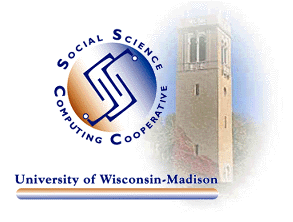
New Sensistive Data Facility Available to SSCC Members
Two New Statistical Procedures in SAS
Print Job Costs on Yellow Cover Sheets
Tip of the Month: Helping SpamAssassin do a Better Job
SSCC now has a small facility, located in the inner room of SSCC's Public Terminal
Room in 2470 Social Sciences, which provides a secure environment for SSCC researchers
to access sensitive data. This facility contains a single stand-alone PC with
a removable hard drive for storing restricted data. (We purchased three removable
drives so up to three projects can use the facility at a time.) Installed software
includes SAS, SPSS, STATA, and MatLab. In order to gain access, we'll need copies
of your approved restricted data agreement and the written authorization from
the appropriate UW Institutional Review Board. Please contact Nancy McDermott
(mcdermot@ssc.wisc.edu, 4325 Social
Sciences, (608) 262-3206) if you are interested in using SSCC's Sensitive Data
Facility.
There is also a second sensitive data facility in the building, operated by
the Center for Demography of Health and Aging (CDHA). SSCC's facility is for
sensitive data sets that do not require the same level of security as the CDHA
facility but still need to be isolated from the network.
There are two new statistical procedures available in SAS that may prove useful for your research: PROC MDC and PROC QLIM. The MDC (Multinomial Discrete Choice) procedure is for analyzing models where the choice set consists of multiple alternatives. The MDC procedure supports conditional (or multinomial) logit, mixed logit, nested logit, and multinomial probit models using maximum likelihood or simulated maximum likelihood methods for model estimation. More information is available at http://support.sas.com/rnd/app/papers/mdc.pdf.
The QLIM (Qualitative and LImited dependent variable Model) procedure analyzes
univariate and multivariate limited dependent variable models where dependent
variables take discrete values or dependent variables are observed only in a
limited range of values. This procedure includes logit, probit, tobit, and general
simultaneous equations models. The simultaneous equations model can contain
discrete choice and limited endogenous variables as well as continuous endogenous
variables. The QLIM procedure mainly uses the maximum likelihood method for
the single equation model or reduced form equations of the simultaneous equations
model. The structural parameters are estimated in the second stage using the
least squares method. The experimental QLIM procedure supports linear regression
model with heteroscedasticity, Box-Cox regression with heteroscedasticity, binary
probit and logit with heteroscedasticity, ordinal probit and logit with heteroscedasticity,
simple multinomial logit, conditional logit, and tobit (censored and truncated)
with heteroscedasticity models. More information is available at http://support.sas.com/rnd/app/papers/qlim.pdf.
Last year SSCC users printed over 1,000,000 pages! Even though you are fortunate not to get charged for printing on an individual basis, your sponsoring agency or department does get charged. SSCC has special software that tracks printing usage for each SSCC member and this information is included with other usage information to allocate agency costs at the end of each fiscal year. We are now printing an estimated cost on the yellow cover sheet of Windows print jobs to make you more aware of what printing costs.
Printing costs have soared over the past few years due to the vast amount of information available on the web. You can help keep the cost of printing down by always printing double-sided and printing two pages per sheet of paper when possible. Please note that it is SSCC policy to print only one copy of a file. Please use a copier if you need multiple copies
Last month we announced
new software called SpamAssassin for filtering SPAM e-mail. Now that you've
set up SpamAssassin to filter your email, help it learn more quickly what you
consider legitimate email and what you consider spam by using the "not
spam" and "not legit" mailboxes that was created when you set
up SpamAssassin. If you have a message that ended up in your spam mailbox but
shouldn't have, move that message to the "not spam" mailbox. If you
have mail that you consider spam but SpamAssassin doesn't, move that message
to the "not legit" mailbox. Each night, SpamAssassin will check those
mailboxes to see what mistakes it made and learn from them. SpamAssassin will
move all mail from the "not spam" mailbox to your Inbox when it is
finished, and will delete all mail in the "not legit" mailbox. If
you can't see your "not legit" or "not spam" mailboxes,
update your mailbox list. In Eudora, right-click on "Dominant" in
the mailboxes list and choose "Refresh Mailbox List." More information
on SpamAssassin see SSCC Publication, Filtering
Your Email with SpamAssassin.
Go to previous editions of
SSCC News.
Go to the SSCC Home Page.
© 2003 University of Wisconsin Social Science Computing Cooperative